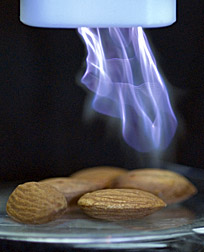This page has been archived and is being provided for reference purposes only. The page is no longer being updated, and therefore, links on the page may be invalid.
|
|
|
|
Food Safety Developments Are in the Air
By Laura McGinnisJuly 22, 2008
An experimental treatment from the Agricultural Research Service (ARS) could one day help protect some fresh produce from potentially dangerous microbes such as Salmonella, Listeria and Escherichia coli O157:H7.
The treatment relies on cold plasma, which is generated when some form of concentrated energy--in this case, electricity--is introduced into a gas until free electrons are torn from the gas's atoms.
This plasma-forming process is related to the technology used to create plasma for computer chips. But in addition to increasing conductivity, the process of turning gas into plasma has an antimicrobial effect. The ARS researchers aren't the first to harness this technology for food safety purposes, but their method of production has the potential for increased efficiency and lower costs when applied at a larger scale.
To make plasma, other food safety scientists use gas mixtures that include exotic gases like helium or argon, but the ARS team is using the cheapest gas mixture available: air.
In addition to its economic benefits, air--unlike other gases--doesn't need to be confined to a closed chamber during plasma production. This means that at a pilot scale, this particular method of plasma treatment could be done continuously, on a conveyor belt, which would translate to better efficiency and increased cost savings.
At the ARS Eastern Regional Research Center in Wyndmoor, Pa., microbiologist Brendan Niemira and engineer Joseph Sites--who are developing the process--exposed Golden Delicious apple samples to various microbial pathogens. Then they treated the samples with plasma.
The scientists observed that any exposure to the plasma resulted in a significant reduction in pathogen numbers without harming the apples. Raising the air flow rate and length of exposure increased the antimicrobial activity.
The research was conducted at a laboratory scale and is still in experimental stages. Future studies will include other types of produce and expand the scale of the plasma-creation process.
This research was published in the July 2008 issue of the Journal of Food Protection.
ARS is a scientific research agency of the U.S. Department of Agriculture.

